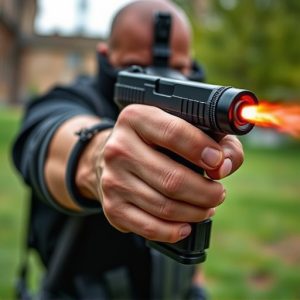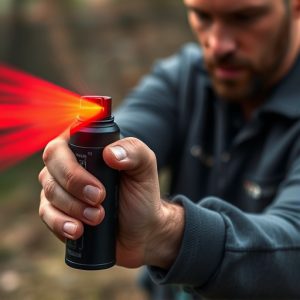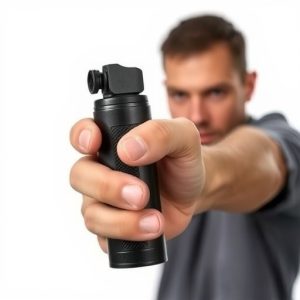Understanding and Optimizing Pepper Spray: Duration, Composition & Safety
Pepper spray, a non-lethal weapon using capsaicin from chili peppers, disables individuals temporari…….
Pepper spray, a non-lethal weapon using capsaicin from chili peppers, disables individuals temporarily (2-15 minutes). Its effects depend on factors like capsaicin concentration, weather, exposed area, clothing, and skin sensitivity. Proper training and responsible use by officers are vital for public safety. Understanding the duration of pepper spray's effects is crucial for tactical utility evaluation in law enforcement, especially crowd control or subduing suspects. Always prioritize safety by wearing protective gear, ensuring ventilation, maintaining distance, and considering environmental conditions.
“Uncover the power behind police-grade inflammatory pepper spray compounds, a crucial non-lethal weapon in law enforcement. This comprehensive guide delves into the intricate composition of these powerful agents, focusing on their active ingredients and how they interact. We explore the duration of pepper spray effects, revealing insightful data on ‘How Long Pepper Spray Effects Last’. Additionally, we uncover factors influencing retention time and provide essential safety measures for responsible use, ensuring both effectiveness and user protection.”
- Understanding Pepper Spray Composition and Its Active Ingredients
- The Duration of Pepper Spray Effects: A Comprehensive Overview
- Factors Influencing Pepper Spray Retention Time
- Safety Measures and Best Practices When Using Pepper Spray
Understanding Pepper Spray Composition and Its Active Ingredients
Pepper spray, a widely used non-lethal weapon by law enforcement agencies, is comprised of various compounds designed to cause temporary incapacitation. The primary active ingredient in most pepper sprays is capsaicin, a compound extracted from chili peppers. This chemical irritates the eyes, nose, and respiratory system, leading to symptoms like tearing, coughing, difficulty breathing, and pain.
The duration of pepper spray effects can vary based on factors such as concentration, amount sprayed, weather conditions, and individual sensitivity. Typically, the effects can last between 2 to 15 minutes, making it an effective yet temporary measure for crowd control or to subdue an individual. Understanding these components and their impact is crucial in assessing the tactical applications and potential risks associated with pepper spray use.
The Duration of Pepper Spray Effects: A Comprehensive Overview
The effects of pepper spray are designed to be temporary, but the duration can vary depending on several factors. Typically, the active ingredient in pepper spray, capsaicin, causes a burning sensation and temporarily disables an individual by affecting their respiratory system and vision. On average, the impact of pepper spray can last for about 2-5 minutes, making it an effective non-lethal weapon for law enforcement.
However, in some cases, the effects may persist for longer periods, especially if the subject has pre-existing respiratory conditions or is exposed to high concentrations of the spray. In extreme situations, symptoms can last up to half an hour or more. It’s crucial to remember that the length of these effects doesn’t indicate long-term damage; instead, it highlights the need for proper training and responsible use by police officers to ensure public safety.
Factors Influencing Pepper Spray Retention Time
The retention time of pepper spray, or how long its effects last, is influenced by several factors. One key determinant is the concentration of capsaicin, the primary active ingredient responsible for the burning sensation and respiratory distress it causes. Higher concentrations generally result in longer-lasting effects due to increased potency. Weather conditions also play a significant role. In humid environments, pepper spray tends to dissipate faster as moisture can dilute its strength. Conversely, dry conditions can prolong its effectiveness.
The surface area exposed and the individual’s clothing or skin type can further modify retention time. Clothing acts as a barrier, sometimes reducing the spray’s impact by slowing down its absorption. Skin sensitivity varies from person to person; those with more sensitive skin might experience effects for longer periods compared to individuals with less reactive skin. Additionally, temperature affects how quickly pepper spray evaporates, with warmer temperatures generally leading to quicker dissipation.
Safety Measures and Best Practices When Using Pepper Spray
When utilizing pepper spray, safety is paramount. It’s crucial to wear protective eyewear and clothing to shield yourself from direct contact with the spray, as it can cause severe irritation or even chemical burns. Always ensure adequate ventilation in the area; if possible, use the spray outdoors or in a well-ventilated space to prevent the buildup of noxious gases.
Best practices dictate that users maintain a safe distance from the target and any bystanders. The effects of pepper spray can last for several minutes, so it’s essential to give the affected individual time to recover without posing additional risks. Additionally, be mindful of environmental factors; wet or windy conditions can impact the spray’s effectiveness and range, while dry, hot weather can intensify its intensity.
Pepper spray, a powerful law enforcement tool, has been meticulously formulated with specific compounds to disrupt and incapacitate individuals. Understanding its composition, duration of effects, and influencing factors is crucial for both professionals and those seeking self-defense options. This article has explored the active ingredients, highlighting their roles in creating a safe and effective deterrent. Moreover, it’s important to note that proper usage practices, including retention time considerations, are key to minimizing risks and maximizing its impact. By grasping these concepts, users can make informed decisions regarding pepper spray as a temporary yet potent solution during critical situations.


